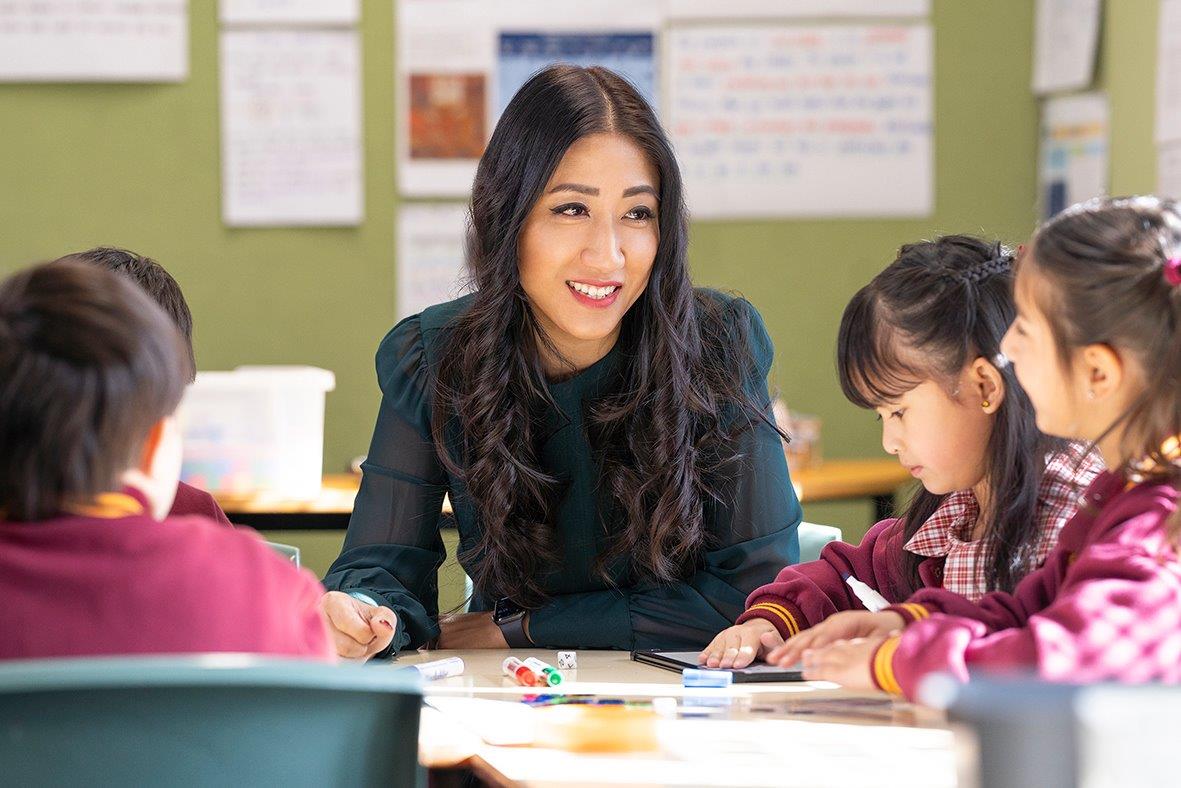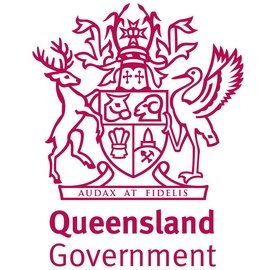Mai advocates the importance of community and explicit teaching methods, particularly in addressing declining numeracy results. She has introduced core programs to ensure a consistent curriculum throughout her students’ primary schooling and used a growth and achievement Scatterplot tool to outstanding success.
Grant Quarry: You have been at Lansvale Public School since 2009 when you did your prac. What is it that keeps you there?
Mai Anh Lu: It’s the community, the teachers, the students – I just love it. We’re very connected to our community and that’s really important to me, because I’ve got children of my own, and as a parent I want a school that connects with community.
GQ: Can you tell me a bit about your school?
MAL: We’re a P-6 school. Currently we have around 650 students, including 70 preschool kids, but our school is declining in numbers. Around 94 per cent have English as a second language, so many come to school with minimal English. The majority are from Southeast Asia, we’ve got a large Vietnamese community, and we’re growing in terms of our Islander family community.
GQ: So what does your APCI role at Lansvale largely involve?
MAL: So, when the role was created, it was around how we build teacher capacity to improve classroom practice? It involved doing work around professional learning, working with teachers in their classroom; I could be doing demonstration lessons, team teaching and observing lessons, but our goal, ultimately, is 'how can we improve student outcomes?'
GQ: So, how have you enjoyed your two years in the role?
MAL: I very much miss having my own class, so it’s different. Rather than impacting the 30 kids in front of you, I’ve got a classroom of 580 [primary kids] now, so it’s been rewarding to see the impact on that scale.
GQ: You’ve been addressing declining numeracy results and leading an explicit teaching initiative in maths which has seen much improved NAPLAN results. Can you explain a little about how this all transpired?
MAL: For more than four years we persevered with inquiry-based learning of mathematics; we call it ‘mathematics investigation’. However, NAPLAN results in our school really just plummeted. It may work in some contexts, but I think for our kids coming in without the educational background, it just didn’t work for them. We gave it a red-hot go, but they didn’t have that foundation to inquire.
I wasn’t leading curriculum at that time, but with the results showing it wasn’t working, I had to do something. So we looked to the Department’s ‘what works best’ document, and they really advocated explicit teaching. I was like, ‘if they’re saying that it actually boosts student outcomes, we need to maybe go down that path'…
We have a great DEL (Director of Education Leadership), she’s been an enormous help networking with other schools, and we’ve got schools in our area with similar demographics, which is what we wanted. Schools can be very different, a school could be successful, but if they’re in a very different demographical area, [their methods] may not work for us. We had schools in the Fairfield region who really excelled, and I thought ‘What are those schools doing?’ And it was more than explicit teaching, they had a core program which we adopted, and that was the start.

In addition to her classroom initiatives, Mai has championed family and community involvement, and has coordinated extensive support for vulnerable families to ensure children are not left behind.
GQ: So your core, whole-school program has been key to your success as well?
MAL: What we found in the school prior to the APCI role [being created] was across stages, even across grades, our people programmed however they wanted, without really knowing what came before or after. And that’s a real problem, because kids weren’t building upon what they knew, or there were gaps in their knowledge, because the teachers assumed, ‘OK, that should have been taught, I’m just going to teach what I think should be taught’. So the kids’ results got progressively worse over the years, because the gaps kept widening.
We then wrote core programs for K-6, which really built upon what kids have already been learning, but we kept the language consistent as well, so teachers had an understanding of, ‘OK, I’ve got a Year 2 class, I know exactly what has been taught in Year 1' – but if they don’t know it, 'I’m going to go back to that program, which has been written to help my kids’.
Even though we have the core program, the kids are very different from class to class; so you differentiate – ‘this is what we’re telling you to teach, but if the class isn’t ready, you just differentiate’.
That really helps the teachers. There hasn’t been any guessing, like ‘what do I need to teach?’, it’s much more now, ‘I know what I need to teach’. It really reduces the cognitive load for teachers, too.
GQ: With the aid of Scatterplot you’ve also been able to measure growth and achievement. For it to be so effective, there must have been complete buy-in from your staff?
MAL: They did get on board. I think it’s because of the ‘why’ – this is why we’re doing this, because this is what the data shows us. But we also collected information from teachers, like ‘how are you feeling about teaching mathematics?’ I remember at the very beginning of 2022 when I did the role, I think less than half were confident in teaching maths. And I thought, if the teachers aren’t confident teaching maths, then the students aren’t going to learn it.
However, by the end of just the first year, we had over 90 per cent who then felt confident, because it was really clear to them what they had to teach, and how they had to teach it. It wasn’t a guess from class to class and it was a big shift just in the first 12 months in the teachers' confidence...
We’ve done our PATs (Progressive Achievement Tests) for two years now ... and last year we had 67 per cent of kids making at least a year’s growth. Other kids are making growth as well, but not really close to a year ... Knowing that we do have complex kids who may not make the years’ growth, it’s going to be challenging to ever get 100 per cent, because we have those kids with diagnosed learning needs, but the majority are making growth, which is what we want.
GQ: So you’ve seen enough evidence to suggest that, ‘OK, this is working’, and you’re really pleased with the results so far?
MAL: Yes, there are so many stakeholders. Every year, we ask the teachers ‘how are you still feeling?’ ‘How can we support you in different ways?’ This changes over the years. But also for students, we’re asking ‘How do you feel about maths? Do you feel challenged?’ Because the students are at the heart of what we do, if we don’t get from them how they feel, it’s like we’ve really missed a whole chunk of data.
Every year we ask the kids these questions and the majority say they love maths, and they actually feel challenged. I think it comes down to the fact that if [the instruction has] been differentiated and we are meeting them where they’re at, they feel that challenge, because it’s not too hard for them (but) it’s not too easy... And that has been quite consistent over the years.
GQ: You’re an ambassador for Seesaw, has that been hugely beneficial at your school, particularly given you’ve so many language barriers with parents?
MAL: As a parent, you like to know what your kids are doing in their classroom, but when you ask ‘how was your day at school?’ or ‘what did you do?’ the response might be ‘oh nothing’, or something similar. And so I thought, ‘How do I get this window into a child’s learning?’ Seesaw allows us to do that, because the teachers take photos and make videos, the kids can do their own as well and it’s like a digital portfolio, and it’s connected to parents. I say it’s like a Facebook for school – that’s what it’s like for me. The kids post their own work on things and it’s directly linked to the parents as parents get notifications.
While the tool’s given parents an insight into their children’s passion, it’s now also used as a communication tool between teachers and parents. The relationships with parents and teachers, I feel, has been strengthened, because they have a tool to connect with a teacher, as opposed to a formal face-to-face meeting or phone call.
The critical difference inbuilt into the app is also a translation function, so if I send a note home on Seesaw, and the parents’ language is Vietnamese, it will translate it for them. It can automatically do that for our parents in many, many different languages. It sort of bridges that communication divide, and the parents love seeing what their kids do.

Mai’s role as an ambassador for Seesaw has helped lead to the app’s adoption across all NSW classrooms, enhancing formative assessment, teaching practices, student technology skills, and school-parent partnerships.
GQ: So what other things have you been able to introduce or foster, to help vulnerable families in your community?
MAL: We have an amazing staff member who oversees our ‘Schools as Community Centres’ program. She’s the bridge, I suppose, between parents and the school. We run a lot of parent workshops because our parents are very aspirational, but they also come from backgrounds where the learning was very different. For them it’s like, ‘I want to help to teach my child, but I don’t know how to’.
We do a lot of workshops for our parents, with translators, so the parents feel like it’s more inclusive. We’ve done that every term for parents around literacy and numeracy, and we’re now running workshops around wellbeing and parenting as well.
A lot of parents also work, so that’s where Seesaw comes in handy again, because anything that they can’t get to at school during school time, we send it through Seesaw.
GQ: In terms of challenges at your school, what do you consider to be amongst the biggest?
MAL: The biggest challenge I suppose is around our declining numbers, but the kids who are coming in have myriad complexities around learning, around behaviour, around speech, and around attention. I think it’s to do with the digital age in which they’re growing up as well, which is only compounding the challenge that we are facing as teachers.
GQ: And lastly, how did you enjoy your visit to Parliament House in Canberra to receive your award?
MAL: I think what I really loved about the night was how diverse the winners’ stories are.
In our schools, I guess, we only see what we see, we don’t know what else is happening out there, so seeing the diversity in the work that teachers are doing, was just amazing.
Because I love learning, I want to instil that in our kids. I want to keep learning and have an opportunity for the next 12 months to really connect with these Fellows and learn more for myself – because the more you learn, the better you do. That’s the most exciting part for me, getting to learn from all the other great educators.
For more information on the Commonwealth Bank Teaching Awards presented by Schools Plus, click here.
















